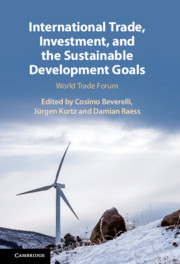Book contents
- International Trade, Investment, and the Sustainable Development Goals
- International Trade, Investment, and the Sustainable Development Goals
- Copyright page
- Contents
- Figures
- Tables
- Contributors
- Preface
- Introduction
- Part I Penetration and Diffusion of the Sustainable Development Goals
- Part II Top-Down: Public Approaches to Achieving the Sustainable Development Goals
- Part III Bottom-Up: Private Sector and Civil Society Initiatives on the Sustainable Development Goals
- 6 Voluntary Standards, Trade, and Sustainable Development
- 7 The Role of Voluntary Sustainability Standards in Sustainable Livelihoods for Cocoa Farmers in Côte d’Ivoire
- 8 Unblocking the Trade Pipes
- 9 The Effects of Environmental Costs on Public Support for Foreign Direct Investment
- Conclusion
- Index
- References
8 - Unblocking the Trade Pipes
Using Blockchain Technology to Facilitate Trade for Sustainable Development
from Part III - Bottom-Up: Private Sector and Civil Society Initiatives on the Sustainable Development Goals
Published online by Cambridge University Press: 18 September 2020
- International Trade, Investment, and the Sustainable Development Goals
- International Trade, Investment, and the Sustainable Development Goals
- Copyright page
- Contents
- Figures
- Tables
- Contributors
- Preface
- Introduction
- Part I Penetration and Diffusion of the Sustainable Development Goals
- Part II Top-Down: Public Approaches to Achieving the Sustainable Development Goals
- Part III Bottom-Up: Private Sector and Civil Society Initiatives on the Sustainable Development Goals
- 6 Voluntary Standards, Trade, and Sustainable Development
- 7 The Role of Voluntary Sustainability Standards in Sustainable Livelihoods for Cocoa Farmers in Côte d’Ivoire
- 8 Unblocking the Trade Pipes
- 9 The Effects of Environmental Costs on Public Support for Foreign Direct Investment
- Conclusion
- Index
- References
Summary
The emergence of blockchain technology has the potential to disrupt nearly anything from voting to healthcare, but could it help deliver the Sustainable Development Goals? International trade has been identified as an instrument in achieving these goals but in practice bottlenecks and trade frictions persist. This chapter aims to illuminate how blockchain technology can smooth three stubborn trade frictions: trade finance gaps, low preference utilisation, and customs frictions. We detail the channels through which blockchain technology can smooth these trade frictions. We then estimate the magnitude of potential economic effects and consider their contributions to these goals. We also discuss how policymakers can create an ecosystem to facilitate these advancements in trade and sustainable development.
Keywords
- Type
- Chapter
- Information
- International Trade, Investment, and the Sustainable Development GoalsWorld Trade Forum, pp. 228 - 269Publisher: Cambridge University PressPrint publication year: 2020
References
- 1
- Cited by

